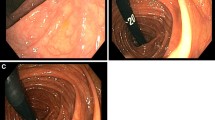Abstract
PURPOSE: Retroflexion of the endoscope during rectal examination may increase diagnostic yield but is not routinely performed because of concerns about safety and a lack of appreciation of its importance. The purpose of this study was to examine the yield, safety, and tolerance of endoscopic rectal retroflexion. METHODS: Prospective cohorts of subjects undergoing unsedated screening flexible sigmoidoscopy were examined with and without routine retroflexion. Pain scores were recorded. RESULTS: A total of 526 subjects (mean age 60 (range, 55–66) years) underwent flexible sigmoidoscopy in the first period when the endoscope was not routinely retroflexed. Of these, 480 (mean age 60 (range, 55–66) years) were subsequently examined with routine retroflexion. Retroflexion was impossible in 17 subjects (3.5 percent) because of discomfort. In the second group, 12 subjects (2.5 percent) had polyps in the lower rectum seen only on retroflexion. Of these, eight had metaplastic and four had adenomatous polyps (3 tubular <5 mm, 1 tubulovillous 15 mm). There was no difference in mean pain scores between the groups (no retroflexion=2.13, retroflexion=2.18). CONCLUSION: With an adenoma pick-up rate of 8 to 12 percent for screening flexible sigmoidoscopy, retroflexion increases adenoma detection by approximately 1 percent without adverse effects and should be an integral part of flexible sigmoidoscopy.
Similar content being viewed by others
References
Schrock TR. Colonoscopy versus barium enema in the diagnosis of colorectal cancers and polyps. Gastrointest Endosc Clin North Am 1993;3:585–610.
Warneke J, Petrelli N, Herrera L, Nava H. Accuracy of colonoscopy for the detection of colorectal polyps. Dis Colon Rectum 1992;35:981–5.
Rex DK, Cutler CS, Lemmel GT,et al. Colonoscopic miss rates of adenomas determined by back-to-back colonoscopies. Gastroenterology 1997;112:24–8.
Devesa SS, Chow WH. Variation in colorectal cancer incidence in the United States by subsite of origin. Cancer 1993;71:3819–26.
Grobe JL, Kozarek RA, Sanowski RA. Colonoscopic retroflexion in the evaluation of rectal disease. Am J Gastroenterol 1982;77:856–88.
Esber EJ, Yang P. Retroflexion of the sigmoidoscope for the detection of rectal cancer. Am Fam Physician 1995;51:1709–11.
Atkin WS, Cuzick J, Northover JMA, Whynes DK. Prevention of colorectal cancer by once-only sigmoidoscopy. Lancet 1993;341:736–40.
Author information
Authors and Affiliations
About this article
Cite this article
Hanson, J.M., Atkin, W.S., Cunliffe, W.J. et al. Rectal retroflexion. Dis Colon Rectum 44, 1706–1708 (2001). https://doi.org/10.1007/BF02234394
Issue Date:
DOI: https://doi.org/10.1007/BF02234394




